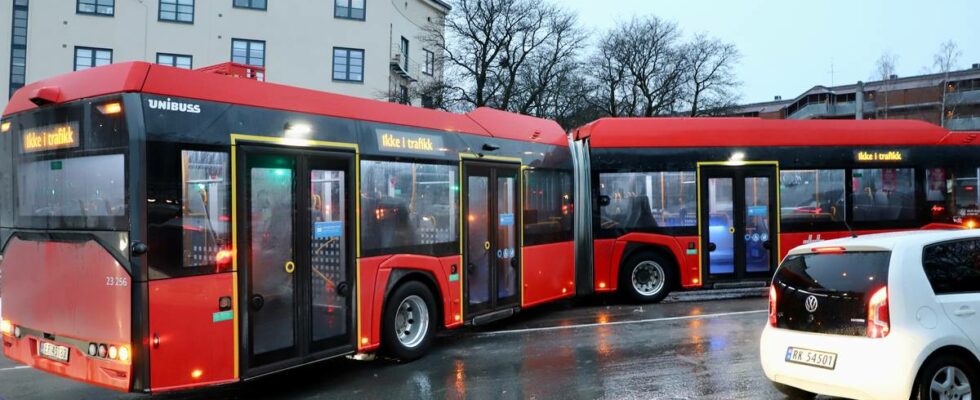– We are better equipped this year, says director of operations at Ruter, Møyfrid Aandstad. Last winter was an ordeal for bus passengers in the Oslo area. When the cold set in, even the professionals were surprised at how quickly the electric buses ran out of power. When the snow melted in January, the entire bus service was at times paralyzed. – There may also be days in winter when the weather conditions are so challenging that we will have problems delivering the full range. – Then we also have a plan for that, says Aandstad. NEW HEATING DEVICE: Retrofitted biodiesel burners are one of many measures to make bus traffic more reliable, says operations director Møyfrid Aandstad in Ruter. Photo: Bård Nafstad / news Biodiesel burners One thing Ruter thinks was particularly bad: That they were unable to have a normal offer on normal, cold winter days, because the electric buses were discharging. Two Unibus contracts were particularly hard hit. It concerns the 183 Solaris buses in the inner city and 76 MAN buses in the north-east of Oslo. – On the really cold days, we saw that around 50 per cent of all energy consumption only went to heating the compartment in the bus, says Glenn-Ivar Gaalaas. He is head of fleet and infrastructure at Unibuss. The buses today are the same, but things are happening on the technology front. At Unibuss’ facility at Stubberud in Groruddalen, the company and Ruter are showing off the first of the Solaris buses which have been retrofitted with an HVO burner to heat the passenger compartment. During the winter, all the buses in the inner city will have a new heater powered by biodiesel. Then they do not need to drain the battery to create a livable temperature inside the bus. – It gives a significantly longer range, says Gaalaas. BIODIESEL: The heaters must prevent up to half the battery capacity from being used to heat the compartment on the bus. Photo: Bård Nafstad / news Extra battery The MAN buses in the northeast do not have room for an additional burner. They get an extra battery pack instead. – We are also reinforcing three bus depots with more and better chargers, says Gaalaas. In addition, Ruter has set up shorter routes in several places so that the buses can charge more often. MORE AND BETTER CHARGERS: Glenn-Ivar Gaalaas in Unibuss talks about better charging infrastructure, including at the bus facility at Stubberud near Alnabru. Photo: Bård Nafstad / news Metal plates with green soap Another technical problem last winter was buses skidding on the smooth ice, even on flat ground. This particularly applied to articulated buses with the drive wheels at the rear. – We have now corrected the software on the buses’ anti-spin functionality, so that it is a little more sensitive and better suited for winter operation. – It should ensure that we don’t spin when it’s slippery outside, in the same way as we did last year, says Glenn-Ivar Gaalaas in Unibuss. The tests were carried out on both plastic and metal plates smeared with green soap and other smoothing agents. Better plans On Wednesday there is an open hearing in the Oslo City Council about the bus chaos last winter and what can be done differently. The investigation report came in June. Ruter has collected all the preparations for a new winter under eight headings: – We have worked a lot on emergency plans, both together with the Urban Environment Agency and our operators, says Møyfrid Aandstad in Ruter. She talks about action plans right down to street level. – If it is not passable on part of the route, we can exclude, for example, three stops and direct the bus into another street. Then we manage to maintain the rest of the route. SPENT ON FLAT LAND: Unibuss has updated the anti-spin function on the articulated buses to prevent them from spinning as fast as last winter. Photo: Nadir Mohammad Alam / news If the weather conditions get even worse, Ruter has plans for what they call a controlled drawdown of the offer. – We cover all areas, but run at a slightly lower capacity if there is a challenge, says Aanstad. Must expect problems The weather does not rule Routes over. They cannot promise that travelers will not have to experience days where bus traffic collapses. – It is very difficult to predict. We probably had two days in January where, so to speak, everything came to a standstill. They closed the airport, the railway stopped, most everything stood still. – We experienced that the plow trucks did not arrive. Then we won’t get the buses there either, says the director of operations. Spiked or not spiked? If the buses are to arrive, they must at least be properly shod. Møyfrid Aandstad in Ruter says that the bus companies themselves choose tires based on bus type and route. Previously, operators who wanted to drive with studded tires had to apply for it. Now it is enough that they give notice. Glenn-Ivar Gaalaas in Unibuss says that they drive with all-season tires all year round. In practice, this means studless winter tires marked M+S; “Mud and Snow” (mud and snow). – We will change to new tires before 1 November, he says. TIRE TEST: Ruter has been to Finland and carried out tire tests to find out what is best. The results are not yet clear. Photo: Juha Kauppinen Published 11.09.2024, at 07.21
ttn-69
This is how Ruter and Unibus will avoid new bus chaos this winter – Greater Oslo

